


Read Surah’s from Quran along with the meaning in language of your preference. Best Quran translations that can help anyone learn Arabic from Quran and also learn the Holy Quran in any language. In fact this is the easiest way to learn Arabic. - Amin
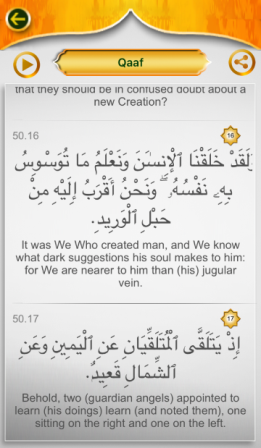
Every Salah has a verse by verse meaning and translation. The translation can be read and understood with the progressive text offered by Quran feature. Quran in Progressive text is offered by no other app in this category. Quran in MP3 (audio Quran), Live Quran can be listen to.
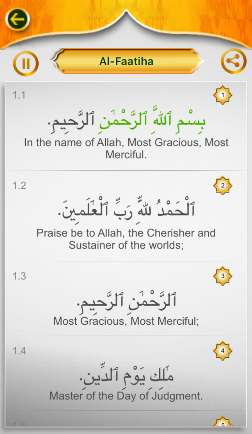
Listen to the Holy Quran in the voice of Al-Sudais, the renowned Maulwi/Imam. Along with this it also offers best Quran translation. Learn the teachings of Allah in the voice of most eminent imams and maulwis.
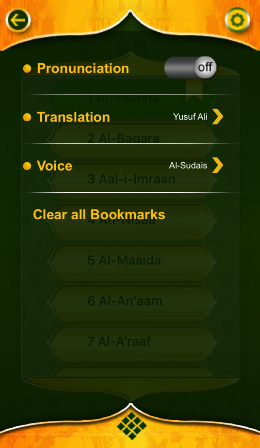
There are a host of settings that can be done for Quran such as Pronunciation toggle, Select a language to translate, Voice of an Imam. Quran in all languages is available on offer. You can now bookmark Quran as well and start reading from where you left in between last time (which you should not do).
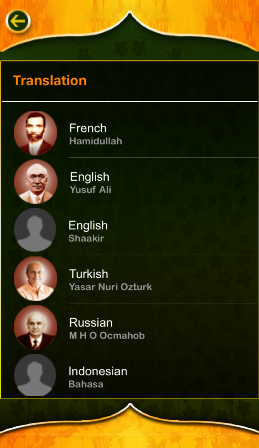
Get Translation of Quran in various languages such as Quran in English, Quran in French, Quran in Uzbek, Quran in Malay, Quran in Bangla, Quran in Hausa, Quran in Russian, Quran in Indonesian, Quran in Turkish, Quran in German and Quran in Urdu and connected with Allah.
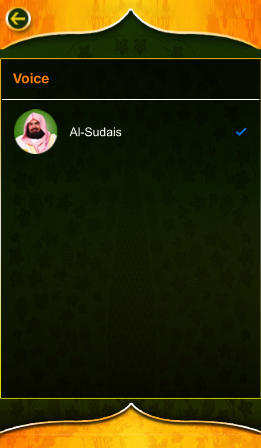
Listen to the Quran In the famous voice of Al-Sudais. More voices of Imam’s from around the world coming soon.
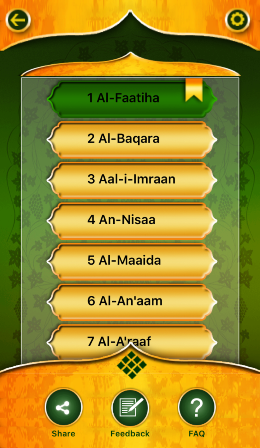
Share the features with the Muslim community on the social network or leave a feedback for the developers.
The Quran (/kɔːrˈɑːn/ kor-ahn; Arabic: القرآن al-Qurʾān, literally meaning "the recitation"; also Romanized Qur'an or Koran) is the central religious text of Islam, which Muslims believe to be a revelation from God (Arabic: الله, Allah). It is widely regarded as the finest piece of literature in the Arabic language. The Quran is divided into chapters (surah in Arabic), which are then divided into verses (ayah).
Muslims believe the Quran was verbally revealed by God to Muhammad through the angel Gabriel (Jibril), gradually over a period of approximately 23 years, beginning on 22 December 609 CE, when Muhammad was 40, and concluding in 632, the year of his death. Muslims regard the Quran as the most important miracle of Muhammad, a proof of his prophet hood, and the culmination of a series of divine messages that started with the messages revealed to Adam and ended with Muhammad. The word "Quran" occurs some 70 times in the text of the Quran, although different names and words are also said to be references to the Quran.
According to the traditional narrative, several companions of Muhammad served as scribes and were responsible for writing down the revelations. Shortly after Muhammad's death, the Quran was compiled by his companions who wrote down and memorized parts of it. These codices had differences that motivated the Caliph Uthman to establish a standard version now known as Uthman's codex, which is generally considered the archetype of the Quran known today. There are, however, variant readings, with mostly minor differences in meaning.
The Quran assumes familiarity with major narratives recounted in the Biblical scriptures. It summarizes some, dwells at length on others and, in some cases, presents alternative accounts and interpretations of events. The Quran describes itself as a book of guidance. It sometimes offers detailed accounts of specific historical events, and it often emphasizes the moral significance of an event over its narrative sequence. The Quran is used along with the hadith to interpret sharia law. During prayers, the Quran is recited only in Arabic.
Someone who has memorized the entire Quran is called a hafiz. Some Muslims read Quranic ayah (verse) with elocution, which is often called tajwid. During the month of Ramadan, Muslims typically complete the recitation of the whole Quran during tarawihprayers. In order to extrapolate the meaning of a particular Quranic verse, most Muslims rely on the tafsir.
The word qurʼān appears about 70 times in the Quran itself, assuming various meanings. It is a verbal noun (maṣdar) of the Arabic verbqaraʼa (قرأ), meaning "he read" or "he recited". The Syriac equivalent is (ܩܪܝܢܐ) qeryānā, which refers to "scripture reading" or "lesson". While some Western scholars consider the word to be derived from the Syriac, the majority of Muslim authorities hold the origin of the word is qaraʼa itself. Regardless, it had become an Arabic term by Muhammad's lifetime. An important meaning of the word is the "act of reciting", as reflected in an early Quranic passage: "It is for Us to collect it and to recite it (qurʼānahu)."
In other verses, the word refers to "an individual passage recited [by Muhammad]". Its liturgical context is seen in a number of passages, for example: "So when al-qurʼān is recited, listen to it and keep silent." The word may also assume the meaning of a codified scripture when mentioned with other scriptures such as the Torah and Gospel.
The term also has closely related synonyms that are employed throughout the Quran. Each synonym possesses its own distinct meaning, but its use may converge with that of qurʼān in certain contexts. Such terms include kitāb (book); āyah (sign); and sūrah (scripture). The latter two terms also denote units of revelation. In the large majority of contexts, usually with a definite article (al-), the word is referred to as the "revelation" (waḥy), that which has been "sent down" (tanzīl) at intervals. Other related words are: dhikr (remembrance), used to refer to the Quran in the sense of a reminder and warning, and ḥikmah (wisdom), sometimes referring to the revelation or part of it.
The Quran describes itself as "the discernment" (al-furqān), "the mother book" (umm al-kitāb), "the guide" (huda), "the wisdom" (hikmah), "the remembrance" (dhikr) and "the revelation" (tanzīl; something sent down, signifying the descent of an object from a higher place to lower place). Another term is al-kitāb (The Book), though it is also used in the Arabic language for other scriptures, such as the Torah and the Gospels. The adjective of "Quran" has multiple transliterations including "quranic", "koranic", and "qur'anic", or capitalised as "Qur'anic", "Koranic", and "Quranic". The term mus'haf ('written work') is often used to refer to particular Quranic manuscripts but is also used in the Quran to identify earlier revealed books. Other transliterations of "Quran" include "al-Coran", "Coran", "Kuran", and "al-Qurʼan".
Based on earlier transmitted reports, in the year 632, after the demise of Muhammad a number of his companions who knew the Quran by heart were killed in a battle by Musaylimah, the first caliph Abu Bakr (d. 634) decided to collect the book in one volume so that it could be preserved. Zayd ibn Thabit (d. 655) was the person to collect the Quran since "he used to write the Divine Inspiration for Allah's Apostle". Thus, a group of scribes, most importantly Zayd, collected the verses and produced a hand-written manuscript of the complete book. The manuscript according to Zayd remained with Abu Bakr until he died. Zayd's reaction to the task and the difficulties in collecting the Quranic material from parchments, palm-leaf stalks, and thin stones and from men who knew it by heart is recorded in earlier narratives. After Abu Bakr, Hafsa bint Umar, Muhammad's widow, was entrusted with the manuscript. In about 650, the third Caliph Uthman ibn Affan (d. 656) began noticing slight differences in pronunciation of the Quran as Islam expanded beyond the Arabian Peninsula into Persia, the Levant, and North Africa. In order to preserve the sanctity of the text, he ordered a committee headed by Zayd to use Abu Bakr's copy and prepare a standard copy of the Quran. Thus, within 20 years of Muhammad's death, the Quran was committed to written form. That text became the model from which copies were made and promulgated throughout the urban centers of the Muslim world, and other versions are believed to have been destroyed. The present form of the Quran text is accepted by Muslim scholars to be the original version compiled by Abu Bakr.
According to Shia, Ali ibn Abi Talib (d. 661) compiled a complete version of the Quran shortly after Muhammad's death. The order of this text differed from that gathered later during Uthman's era in that this version had been collected in chronological order. Despite this, he made no objection against the standardized Quran and accepted the Quran in circulation. Other personal copies of the Quran might have existed including Ibn Mas'ud's and Ubay ibn Ka'b's codex, none of which exist today.
The Quran most likely existed in scattered written form during Muhammad's lifetime. Several sources indicate that during Muhammad's lifetime a large number of his companions had memorized the revelations. Early commentaries and Islamic historical sources support the above-mentioned understanding of the Quran's early development. The Quran in its present form is generally considered by academic scholars to record the words spoken by Muhammad because the search for variants has not yielded any differences of great significance. University of Chicago professor Fred Donner states that "..There was a very early attempt to establish a uniform consonantal text of the Qurʾān from what was probably a wider and more varied group of related texts in early transmission. After the creation of this standardized canonical text, earlier authoritative texts were suppressed, and all extant manuscripts—despite their numerous variants—seem to date to a time after this standard consonantal text was established. Although most variant readings of the text of the Quran have ceased to be transmitted, some still are. There has been no critical text produced on which a scholarly reconstruction of the Quranic text could be based. Historically, controversy over the Quran's content has rarely become an issue, although debates continue on the subject.
In 1972, in a mosque in the city of Sana'a, Yemen, manuscripts were discovered that were later proved to be the most ancient Quranic text known to exist at the time. The Sana'a manuscripts contain palimpsests, a manuscript page from which the text has been washed off to make the parchment reusable again—a practice which was common in ancient times due to scarcity of writing material. However, the faint washed-off underlying text (scriptio inferior) is still barely visible and believed to be "pre-Uthmanic" Quranic content, while the text written on top (scriptio superior) is believed to belong to Uthmanic time. Studies using radiocarbon dating indicate that the parchments are dated to the period before 671 AD with a 99 percent probability.
In 2015, fragments of a very early Quran, dating back to 1370 years ago, were discovered in the library of the University of Birmingham, England. According to the tests carried out by Oxford University Radiocarbon Accelerator Unit, "with a probability of more than 95%, the parchment was from between 568 and 645". The manuscript is written in Hijazi script, an early form of written Arabic. This is possibly the earliest extant exemplar of the Quran, but as the tests allow a range of possible dates, it cannot be said with certainty which of the existing versions is the oldest. Saudi scholar Saud al-Sarhan has expressed doubt over the age of the fragments as they contain dots and chapter separators that are believed to have originated later.
Muslims believe the Quran to be the book of divine guidance revealed from God to Muhammad through the angel Gabriel over a period of 23 years and view the Quran as God's final revelation to humanity.
Revelation in Islamic and Quranic contexts means the act of God addressing an individual, conveying a message for a greater number of recipients. The process by which the divine message comes to the heart of a messenger of God is tanzil (to send down) or nuzūl (to come down). As the Quran says, "With the truth we (God) have sent it down and with the truth it has come down.
The Quran frequently asserts in its text that it is divinely ordained. Some verses in the Quran seem to imply that even those who do not speak Arabic would understand the Quran if it were recited to them. The Quran refers to a written pre-text, "the preserved tablet", that records God's speech even before it was sent down.
The issue of whether the Quran is eternal or created became a theological debate (Quran's createdness) in the ninth century. Mu'tazilas, an Islamic school of theology based on reason and rational thought, held that the Quran was created while the most widespread varieties of Muslim theologians considered the Quran to be co-eternal with God and therefore uncreated. Sufi philosophers view the question as artificial or wrongly framed.
Muslims believe that the present wording of the Quran corresponds to that revealed to Muhammad, and according to their interpretation of Quran 15:9, it is protected from corruption ("Indeed, it is We who sent down the Quran and indeed, We will be its guardian."). Muslims consider the Quran to be a guide, a sign of the prophet hood of Muhammad and the truth of the religion.
The first sura of the Quran is repeated in daily prayers and in other occasions. This sura, which consists of seven verses, is the most often recited sura of the Quran.
Praised be God, Lord of the Universe, the Beneficent, the Merciful and Master of the Day of Judgment, You alone We do worship and from You alone we do seek assistance, guide us to the right path, the path of those to whom You have granted blessings, those who are neither subject to Your anger nor have gone astray.
Other sections of the Quran of choice are also read in daily prayers.
Respect for the written text of the Quran is an important element of religious faith by many Muslims, and the Quran is treated with reverence. Based on tradition and a literal interpretation of Quran 56:79 ("none shall touch but those who are clean"), some Muslims believe that they must perform a ritual cleansing with water before touching a copy of the Quran, although this view is not universal.[1]Worn-out copies of the Quran are wrapped in a cloth and stored indefinitely in a safe place, buried in a mosque or a Muslim cemetery, or burned and the ashes buried or scattered over water.
In Islam, most intellectual disciplines, including Islamic theology, philosophy, mysticism and jurisprudence, have been concerned with the Quran or have their foundation in its teachings. Muslims believe that the preaching or reading of the Quran is rewarded with divine rewards variously called ajr, thawab or hasanat.
The Quran also inspired Islamic arts and specifically the so-called Quranic arts of calligraphy and illumination. The Quran is never decorated with figurative images, but many Qurans have been highly decorated with decorative patterns in the margins of the page, or between the lines or at the start of suras. Islamic verses appear in many other media, on buildings and on objects of all sizes, such as mosque lamps, metal work, pottery and single pages of calligraphy for muraqqas or albums.
The Quran consists of 114 chapters of varying lengths, each known as a sura. Suras are classified as Meccan or Medinan, depending on whether the verses were revealed before or after the migration of Muhammad to the city of Medina. However, a sura classified as Medinan may contain Meccan verses in it and vice versa. Sura titles are derived from a name or quality discussed in the text, or from the first letters or words of the sura. Suras are arranged roughly in order of decreasing size. The sura arrangement is thus not connected to the sequence of revelation. Each sura except the ninth starts with the Bismillah (بسم الله الرحمن الرحيم), an Arabic phrase meaning "In the name of God". There are, however, still 114 occurrences of the Bismillah in the Quran, due to its presence in Quran 27:30 as the opening of Solomon's letter to the Queen of Sheba.
Each sura consists of several verses, known as ayat, which originally means a "sign" or "evidence" sent by God. The number of verses differs from sura to sura. An individual verse may be just a few letters or several lines. The total number of verses in the Quran is 6,236; however, the number varies if the bismillahs are counted separately.
In addition to and independent of the division into suras, there are various ways of dividing the Quran into parts of approximately equal length for convenience in reading. The 30 juz' (pluralajzāʼ) can be used to read through the entire Quran in a month. Some of these parts are known by names—which are the first few words by which the juzʼ starts. A juz' is sometimes further divided into two ḥizb (plural aḥzāb), and each hizb subdivided into four rubʻ al-ahzab. The Quran is also divided into seven approximately equal parts, manzil (plural manāzil), for it to be recited in a week.
A different structure is provided by semantical units resembling paragraphs and comprising roughly ten ayat each. Such a section is called a rukū`.
The Muqattaʿat (Arabic: حروف مقطعات ḥurūf muqaṭṭaʿāt "disjoined letters" or "disconnected letters", also "mysterious letters") are combinations of between one and five Arabic letters figuring at the beginning of 29 out of the 114 surahs (chapters) of the [Quran just after the basmala. The letters are also known as fawātih (فواتح) or "openers" as they form the opening verse of their respective suras . Four surahs are named for their muqatta'at, Ṭāʾ-Hāʾ, Yāʾ-Sīn, Ṣād and Qāf. The original significance of the letters is unknown. Tafsir (exegesis) has interpreted them as abbreviations for either names or qualities of God or for the names or content of the respective surahs.
According to one estimate the Quran consists of 77,430 words, 18,994 unique words, 12,183 stems, 3,382 lemmas and 1,685 roots.
The doctrine of the last day and eschatology (the final fate of the universe) may be reckoned as the second great doctrine of the Quran. It is estimated that approximately one-third of the Quran is eschatological, dealing with the afterlife in the next world and with the Day of Judgment at the end of time. There is a reference to the afterlife on most pages of the Quran and belief in the afterlife is often referred to in conjunction with belief in God as in the common expression: "Believe in God and the last day". A number of suras such as 44, 56, 75, 78, 81 and 101 are directly related to the afterlife and its preparations. Some suras indicate the closeness of the event and warn people to be prepared for the imminent day. For instance, the first verses of Sura 22, which deal with the mighty earthquake and the situations of people on that day, represent this style of divine address: "O People! Be respectful to your Lord. The earthquake of the Hour is a mighty thing."
"The climax of history, when the present world comes to an end, is referred to in various ways. It is 'the Day of Judgment,' 'the Last Day,' 'the Day of Resurrection,' or simply 'the Hour.' Less frequently it is 'the Day of Distinction' (when the good are separated from the evil), 'the Day of the Gathering' (of men to the presence of God) or 'the Day of the Meeting' (of men with God). The Hour comes suddenly. It is heralded by a shout, by a thunderclap, or by the blast of a trumpet. A cosmic upheaval then takes place. The mountains dissolve into dust, the seas boil up, the sun is darkened, the stars fall and the sky is rolled up. God appears as Judge, but his presence is hinted at rather than described. The central interest, of course, is in the gathering of all mankind before the Judge. Human beings of all ages, restored to life, join the throng. To the scoffing objection of the unbelievers that former generations had been dead a long time and were now dust and mouldering bones, the reply is that God is nevertheless able to restore them to life."
The Quran does not assert a natural immortality of the human soul, since man's existence is dependent on the will of God: when he wills, he causes man to die; and when he wills, he raises him to life again in a bodily resurrection.
According to the Quran, God communicated with man and made his will know through signs and revelations. Prophets, or 'Messengers of God', received revelations and delivered them to humanity. The message has been identical and for all humankind. "Nothing is said to you that was not said to the messengers before you that your lord has at his Command forgiveness as well as a most Grievous Penalty. The revelation does not come directly from God to the prophets. Angels acting as God's messengers deliver the divine revelation to them. This comes out in Quran 42:51, in which it is stated: "It is not for any mortal that God should speak to them, except by revelation, or from behind a veil, or by sending a messenger to reveal by his permission whatsoever He will."
The astrophysicist Nidhal Guessoum while being highly critical of pseudo-scientific claims made about the Quran, has highlighted the encouragement for sciences that the Quran provides by developing "the concept of knowledge." He writes: "The Qur'an draws attention to the danger of conjecturing without evidence (And follow not that of which you have not the (certain) knowledge of... 17:36) and in several different verses asks Muslims to require proofs (Say: Bring your proof if you are truthful 2:111), both in matters of theological belief and in natural science." Guessoum cites Ghaleb Hasan on the definition of "proof" according the Quran being "clear and strong... convincing evidence or argument." Also, such a proof cannot rely on an argument from authority, citing verse 5:104. Lastly, both assertions and rejections require a proof, according to verse 4:174. Ismail al-Faruqi and Taha Jabir Alalwani are of the view that any reawakening of the Muslim civilization must start with the Quran; however, the biggest obstacle on this route is the "centuries old heritage of tafseer (exegesis) and other classical disciplines" which inhibit a "universal, epidemiological and systematic conception" of the Quran's message. The philosopher Muhammad Iqbal, considered the Quran's methodology and epistemology to be empirical and rational.
It's generally accepted that there are around 750 verses in the Quran dealing with natural phenomena. In many of these verses the study of nature is "encouraged and highly recommended," and historical Islamic scientists like Al-Biruni and Al-Battani derived their inspiration from verses of the Quran. Mohammad Hashim Kamali has the stated that "scientific observation, experimental knowledge and rationality" are the primary tools with which humanity can achieve the goals laid out for it in the Quran. Ziauddin Sardar built a case for Muslims having developed the foundations of modern science, by highlighting the repeated calls of the Quran to observe and reflect upon natural phenomenon. "The 'scientific method,' as it is understood today, was first developed by Muslim scientists" like Ibn al-Haytham and Al-Biruni, along with numerous other Muslim scientists.
The physicist Abdus Salam, in his Nobel Prize banquet address, quoted a well-known verse from the Quran (67:3–4) and then stated: "This in effect is the faith of all physicists: the deeper we seek, the more is our wonder excited, the more is the dazzlement of our gaze". One of Salam's core beliefs was that there is no contradiction between Islam and the discoveries that science allows humanity to make about nature and the universe. Salam also held the opinion that the Quran and the Islamic spirit of study and rational reflection was the source of extraordinary civilizational development. Salam highlights, in particular, the work of Ibn al-Haytham and Al-Biruni as the pioneers of empiricism who introduced the experimental approach, breaking way from Aristotle's influence, and thus giving birth to modern science. Salam was also careful to differentiate between metaphysics and physics, and advised against empirically probing certain matters on which "physics is silent and will remain so," such as the doctrine of "creation from nothing" which in Salam's view is outside the limits of science and thus "gives way" to religious considerations.
The Quran has sparked a huge body of commentary and explication (tafsir), aimed at explaining the "meanings of the Quranic verses, clarifying their import and finding out their significance”.
Tafsir is one of the earliest academic activities of Muslims. According to the Quran, Muhammad was the first person who described the meanings of verses for early Muslims. Other early exegetes included a few Companions of Muhammad, like ʻAli ibn Abi Talib, ʻAbdullah ibn Abbas, ʻAbdullah ibn Umar and Ubayy ibn Kaʻb. Exegesis in those days was confined to the explanation of literary aspects of the verse, the background of its revelation and, occasionally, interpretation of one verse with the help of the other. If the verse was about a historical event, then sometimes a few traditions (hadith) of Muhammad were narrated to make its meaning clear.
Because the Quran is spoken in classical Arabic, many of the later converts to Islam (mostly non-Arabs) did not always understand the Quranic Arabic, they did not catch allusions that were clear to early Muslims fluent in Arabic and they were concerned with reconciling apparent conflict of themes in the Quran. Commentators erudite in Arabic explained the allusions, and perhaps most importantly, explained which Quranic verses had been revealed early in Muhammad's prophetic career, as being appropriate to the very earliest Muslim community, and which had been revealed later, canceling out or "abrogating" (nāsikh) the earlier text (mansūkh). Other scholars, however, maintain that no abrogation has taken place in the Quran. The Ahmadiyya Muslim Community has published a ten-volume Urdu commentary on the Quran, with the name Tafseer e Kabir.
Esoteric or Sufi interpretation attempts to unveil the inner meanings of the Quran. Sufism moves beyond the apparent (zahir) point of the verses and instead relates Quranic verses to the inner or esoteric (batin) and metaphysical dimensions of consciousness and existence. According to Sands, esoteric interpretations are more suggestive than declarative, they are allusions (isharat) rather than explanations (tafsir). They indicate possibilities as much as they demonstrate the insights of each writer.
when Moses came at the time we appointed, and his Lord spoke to him, he said, 'My Lord, show yourself to me! Let me see you!' He said, 'you shall not see me but look at that mountain, if it remains standing firm you will see me.' When his Lord revealed Himself to the mountain, He made it crumble. Moses fell down unconscious. When he recovered, he said, 'Glory be to you! I repent to you! I am the first to believe!'
Moses, in 7:143, comes the way of those who are in love, he asks for a vision but his desire is denied, he is made to suffer by being commanded to look at other than the Beloved while the mountain is able to see God. The mountain crumbles and Moses faints at the sight of God's manifestation upon the mountain. In Qushayri's words, Moses came like thousands of men who traveled great distances, and there was nothing left to Moses of Moses. In that state of annihilation from himself, Moses was granted the unveiling of the realities. From the Sufi point of view, God is the always the beloved and the wayfarer's longing and suffering lead to realization of the truths.
Muhammad Husayn Tabatabaei says that according to the popular explanation among the later exegetes, ta'wil indicates the particular meaning a verse is directed towards. The meaning of revelation (tanzil), as opposed to ta'wil, is clear in its accordance to the obvious meaning of the words as they were revealed. But this explanation has become so widespread that, at present, it has become the primary meaning of ta'wil, which originally meant "to return" or "the returning place". In Tabatabaei's view, what has been rightly called ta'wil, or hermeneutic interpretation of the Quran, is not concerned simply with the denotation of words. Rather, it is concerned with certain truths and realities that transcend the comprehension of the common run of men; yet it is from these truths and realities that the principles of doctrine and the practical injunctions of the Quran issue forth. Interpretation is not the meaning of the verse—rather it transpires through that meaning, in a special sort of transpiration. There is a spiritual reality—which is the main objective of ordaining a law, or the basic aim in describing a divine attribute—and then there is an actual significance that a Quranic story refers to.
Translating the Quran has always been problematic and difficult. Many argue that the Quranic text cannot be reproduced in another language or form. Furthermore, an Arabic word may have a range of meanings depending on the context, making an accurate translation even more difficult.
Nevertheless, the Quran has been translated into most African, Asian, and European languages. The first translator of the Quran was Salman the Persian, who translated surat al-Fatiha into Persian during the seventh century. Another translation of the Quran was completed in 884 in Alwar (Sindh, India, now Pakistan) by the orders of Abdullah bin Umar bin Abdul Aziz on the request of the Hindu Raja Mehruk.
The first fully attested complete translations of the Quran were done between the 10th and 12th centuries in Persian. The Samanid king, Mansur I (961–976), ordered a group of scholars from Khorasan to translate the Tafsir al-Tabari, originally in Arabic, into Persian. Later in the 11th century, one of the students of Abu Mansur Abdullah al-Ansari wrote a complete tafsir of the Quran in Persian. In the 12th century, Najm al-Din Abu Hafs al-Nasafi translated the Quran into Persian. The manuscripts of all three books have survived and have been published several times.
Islamic tradition also holds that translations were made for Emperor Negus of Abyssinia and Byzantine Emperor Heraclius, as both received letters by Muhammad containing verses from the Quran. In early centuries, the permissibility of translations was not an issue, but whether one could use translations in prayer.
In 1936, translations in 102 languages were known. In 2010, the Hürriyet Daily News and Economic Review reported that the Quran was presented in 112 languages at the 18th International Quran Exhibition in Tehran.
Robert of Ketton's 1143 translation of the Quran for Peter the Venerable, Lex Mahumet pseudoprophete, was the first into a Western language (Latin). Alexander Ross offered the first English version in 1649, from the French translation of L'Alcoran de Mahomet (1647) by Andre du Ryer. In 1734, George Sale produced the first scholarly translation of the Quran into English; another was produced by Richard Bell in 1937, and yet another by Arthur John Arberry in 1955. All these translators were non-Muslims. There have been numerous translations by Muslims. The Ahmadiyya Muslim Community has published translations of the Quran in 50 different languages besides a five-volume English commentary and an English translation of the Quran.
As with translations of the Bible, the English translators have sometimes favored archaic English words and constructions over their more modern or conventional equivalents; for example, two widely read translators, A. Yusuf Ali and M. Marmaduke Pickthall, use the plural and singular "ye" and "thou" instead of the more common "you".
The oldest Gurumukhi translation of the Quran Sharif in Gurmukhi has been found in village lande of Moga district of Punjab which is around 115 years old, printed in 1911.
The proper recitation of the Quran is the subject of a separate discipline named tajwid which determines in detail how the Quran should be recited, how each individual syllable is to be pronounced, the need to pay attention to the places where there should be a pause, to elisions, where the pronunciation should be long or short, where letters should be sounded together and where they should be kept separate, etc. It may be said that this discipline studies the laws and methods of the proper recitation of the Quran and covers three main areas: the proper pronunciation of consonants and vowels (the articulation of the Quranic phonemes), the rules of pause in recitation and of resumption of recitation, and the musical and melodious features of recitation.
In order to avoid incorrect pronunciation, reciters who are not native speakers of Arabic language try to follow a program of training in countries such as Egypt or Saudi Arabia. The recitations of a few Egyptian reciters were highly influential in the development of the art of recitation. Southeast Asia is well known for world-class recitation, evidenced in the popularity of the woman reciters such as Maria Ulfah of Jakarta.
There are two types of recitation: murattal is at a slower pace, used for study and practice. Mujawwad refers to a slow recitation that deploys heightened technical artistry and melodic modulation, as in public performances by trained experts. It is directed to and dependent upon an audience for the mujawwad reciter seeks to involve the listeners.
Vocalization markers indicating specific vowel sounds were introduced into the Arabic language by the end of the 9th century. The first Quranic manuscripts lacked these marks, therefore several recitations remain acceptable. The variation in readings of the text permitted by the nature of the defective vocalization led to an increase in the number of readings during the 10th century. The 10th-century Muslim scholar from Baghdad, Ibn Mujāhid, is famous for establishing seven acceptable textual readings of the Quran. He studied various readings and their trustworthiness and chose seven 8th-century readers from the cities of Mecca, Medina, Kufa, Basra and Damascus. Ibn Mujahid did not explain why he chose seven readers, rather than six or ten, but this may be related to a prophetic tradition (Muhammad's saying) reporting that the Quran had been revealed in seven "ahruf" (meaning seven letters or modes). Today, the most popular readings are those transmitted by Ḥafṣ(d.796) and Warsh (d. 812) which are according to two of Ibn Mujahid's reciters, Aasim ibn Abi al-Najud (Kufa, d. 745) and Nafi‘ al-Madani (Medina, d. 785), respectively. The influential standard Quran of Cairo (1924) uses an elaborate system of modified vowel-signs and a set of additional symbols for minute details and is based on ʻAsim's recitation, the 8th-century recitation of Kufa. This edition has become the standard for modern printings of the Quran.
The variant readings of the Quran are one type of textual variant. According to Melchert, the majority of disagreements have to do with vowels to supply, most of them in turn not conceivably reflecting dialectal differences and about one in eight disagreements has to do with whether to place dots above or below the line.
Nasser categorizes variant readings into various subtypes, including internal vowels, long vowels, gemination (shaddah), assimilation and alternation.
Occasionally, an early Quran shows compatibility with a particular reading. A Syrian manuscript from the 8th century is shown to have been written according to the reading of Ibn Amir ad-Dimashqi. Another study suggests that this manuscript bears the vocalization of himsi region.